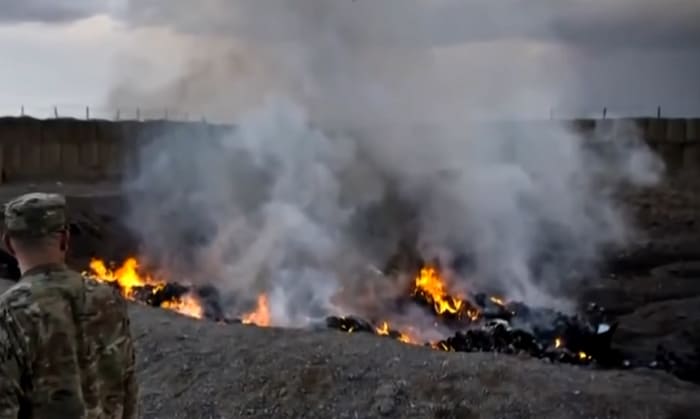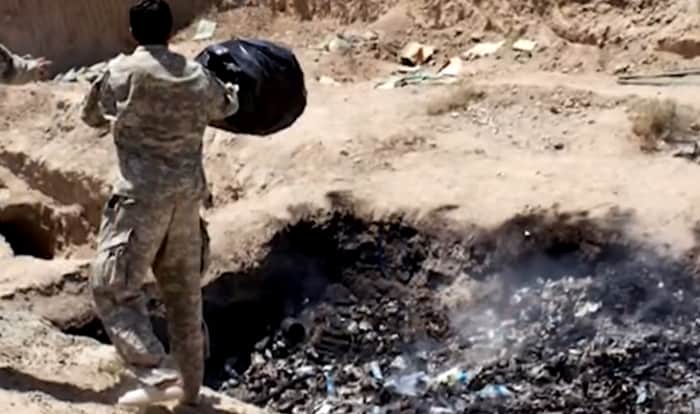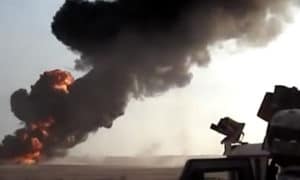If you have been keeping up with military news, you will surely find the PACT Act or Promise to Address Comprehensive Toxics Act familiar. Most headlines mention “burn pits.” But if you are not aware of what these are, you will miss out on the key benefits of the act. So, find the answer to “What are military burn pits?” in this article.
Luckily, the definition is straightforward. A burn pit in the military is an area for waste to be disposed of by burning. However, aside from the burn pits meaning, there are other things worth uncovering about this topic. So, read on to find out.
Table of Contents
- A Detailed Dive Into Military Burn Pits in the US
- First, Let’s Define Burn Pits
- When Were Military Burn Pits Used & Where?
- What Are Some Common Items Disposed of in Burn Pits?
- Why Is Burning Waste in Burn Pits Dangerous?
- Does the US Still Use Burn Pits?
- Is There Any Improvement? What is the US Doing About Burn Pits?
- Is It Possible To Get VA Disability for Burn Pit Exposure?
- How Much Can You Get?
- Conclusion
A Detailed Dive Into Military Burn Pits in the US
First, Let’s Define Burn Pits
Burn pits, as stated earlier, are waste disposal areas. A burn pit in the Army can dispose of waste in four ways: burials, tactical burials, landfills, and incinerators.
Even so, as suggested in the name, burning (incinerating) is the most common waste disposal method.
When Were Military Burn Pits Used & Where?
US military burn pits were used commonly in Iraq and Afghanistan until the mid-2010s.
A well-cited example is the burn pit operation in the largest US base in Iraq: Joint Base Balad / JBB. In the late summer of 2008, the base burned 147 tons of waste per day. The pit itself spanned 10 acres, and each person at the base was estimated to have produced between 3.6 and 4.5 kilograms of waste per day.
Other countries that used to have US military burn pits include:
- Bahrain
- Djibouti
- Kuwait
- Oman
- Qatar
- Saudi Arabia
- Syria
- The United Arab Emirates
- Uzbekistan
Here is a screenshot from a news coverage of a burn pit in Afghanistan:
What Are Some Common Items Disposed of in Burn Pits?
In general, any rubbish collected on military bases is disposed of.
- Chemicals
- Paints
- Food Waste
- Medical Waste
- Human Waste
- Electronic Waste
- Metal and Aluminum Items
- Munitions and Unexploded Ordnance
- Petroleum Products
- Lubricants, Plastics, and Rubbers
Some items, like chemical mixtures and medical wastes, are rather dangerous if not disposed of properly. Plastics and rubber, when burned, are also harmful. They can release toxic smoke that has been linked to rare cancers.
Why Is Burning Waste in Burn Pits Dangerous?
First, burning waste in pits creates clouds of thick and dense black smoke and releases toxins into the air.
Smoke can cause short-term concerns, like:
- Reddened eyes
- Irritated eyes
- Coughing
- Burning throat
- Itchy skin and/or rashes
- Note: Smoke can come in contact with your nose and eyes or penetrate clothes and bedding. It can also coat your skin or food, though inhalation is the most common exposure mode.
Though not exhaustive, here is a list of identified pollutants in burn pits:
- HexaCDD (1, 2, 3, 4, 7, 8, and 9)
- PentaCDD (1, 2, 3, 7, and 8)
- TetraCDD (2, 3, 7, and 8)
- Acenaphthene (ACE)
- Acenaphthylene (ACY)
- Anthracene (ANT)
- Benz[a]anthracene (BaA)
- Benzo[a]pyrene (BaP)
- Benzo[b]fluoranthene (BbF)
- Benzo[e]pyrene (BeP)
- Benzo[k]fluoranthene (BkF)
- Chrysene (CHR)
- Dibenz[a,h]anthracene (DBahA)
- Fluoranthene (FLT)
- Fluorene (FLU)
- Indeno[1,2,3-cd]pyrene (IP)
- Naphthalene
- OctaCDD
- Pyrene (PYR)
Second, burn pits use jet fuel (JP-8) as an accelerant, but it contains a carcinogenic component: Benzene.
- Note: In 2008, service members returning from war zones reported respiratory illnesses. The cases were believed to be because of exposure to burn pits.
That being said, burn pits exposure can entail short-term and long-term health issues. It could be worse if a service member had preexisting problems, such as asthma.
The US Veterans Affairs pinpoint these specific cancers, though they still have not formally acknowledged them as military burn pits cancers:
- The Larynx Squamous cell carcinoma
- The Trachea Squamous cell carcinoma
- The Trachea Adenocarcinoma
- The Trachea Salivary gland-type tumors
- The Lung Adenosquamous carcinoma
- The Lung Large cell carcinoma
- The Lung Salivary gland-type tumors
- The Lung Sarcomatoid carcinoma
- The Lung Typical and atypical carcinoid
Apart from those in the military, pollutants from burn pits can negatively impact locals in the area. Since they cannot leave like troops, they are also bound to face the after-effects.
Other Health Studies & Findings of Burn Pit Consequences
- Some research suggests that burn pit toxins can negatively impact reproductive health outcomes, such as low birth weight, pre-term delivery, and birth defects). There is evidence that they reduce sperm quality, as well.
- The Army Public Health Center has stated that some toxins linked to birth pits suppress antibody response and cause the immune system to become hypersensitive.
- A Veterans Affairs Airborne Hazards and Open Burn Pit Registry study has reported that a third of those exposed to burn pits have high blood pressure.
On that note, what is the Veterans Affairs Airborne Hazards and Open Burn Pit Registry?
It is a department established in 2014 to collect information about service members’ and veterans’ burn pits exposure. Service members and veterans can complete the registry questionnaire to report hazards. Between April 2014 and December 2014, some 30,000 surveys led to a report highlighting:
- The most commonly diagnosed health concerns were neurological problems and insomnia.
- Other diagnosed health concerns were lung disease, allergies, and high blood pressure.
You can access the registry questionnaire at veteran.mobilehealth.va.gov/AHBurnPitRegistry/. You will need your DoD DS-Logon. If you do not already have one, apply for an account at www. dmdc.osd.mil/appj/dsaccess. After completing the questionnaire, you are entitled to an optional in-person medical evaluation, at no extra cost.
Does the US Still Use Burn Pits?
The Department of Defense has not officially banned burn pits. But the use of burn pits has scaled back significantly. At least 9 burn pits were still active in the first quarter of the 2019 fiscal year. In that report to Congress, the Pentagon admits the danger of incineration in the burn pits. Still, claims that it is sticking to act during deployments because local commanders cannot find suitable alternatives.
- Note: The 9 burn pits in 2019 were part of operations in Syria, Afghanistan, and Egypt.
Is There Any Improvement? What is the US Doing About Burn Pits?
Since 2010, the government has been taking measures to minimize the effects of burn pits exposure and in doing so, protect US service members.
In particular, there are policy changes to manage burn pits better and to restrict exposure.
Now, burn pits are supposed to:
- Be at downwind locations
- Be far away from military living areas and civilian living areas
- Be small
- Regulating materials that go into the pits
- Burn 3 hours before sunset and 3 hours after sunrise
And some other notable legislative responses are:
- In May 2009, the Military Personnel War Zone Toxic Exposure Prevention Act was passed to:
- form a medical surveillance system and identify members exposed to hazards
- ban the disposal of waste in a manner that would produce dangerous levels of toxins
- In 2013, the National Burn Pit Registry was signed into law as an addition to the Dignified Burial and Veterans’ Benefits Improvement Act of 2012 by President Obama.
- In September 2018, The Helping Vets Exposed to Burn Pits Act was passed and signed into law by President Donald Trump. It funded $5 million for research, evaluation, and education on burn pit exposure through 2019.
- In 2021, The Promise to Address Comprehensive Toxics (or PACT) Act was passed and signed into law by President Joe Biden. It is meant to address the needs of sick, disabled veterans, and there is a significant focus on those affected by burn pits.
Is It Possible To Get VA Disability for Burn Pit Exposure?
Possibly. The VA does recognize that exposure to burn pits can cause severe health problems. You can file a claim for compensation and benefits if you were exposed to toxins from burn pits, but you will need to prove that you have one of the following to be eligible:
- Asthma, chronic rhinitis, and/or chronic sinusitis and
- Developed one of the listed conditions within 10 years of leaving the military and
- If you have been a part of one of the following:
- Operation Enduring Freedom
- Operation Iraqi Freedom
- Operation New Dawn
- Operation Desert Shield
- Operation Desert Storm
Or was in:
- Djibouti, Africa on or after September 11, 2001
- Southwest Asia on or after August 2, 1990
- Note: If you are not certain about your eligibility, reach out to a VA health care provider.
How Much Can You Get?
According to vetshq.com, Burn pit compensation can range from $1,500 to $39,000 a year, depending on your determined VA disability rating.
Conclusion
As you have read, the answer to, “What are military burn pits?” is straightforward. A burn pit is simply an open area for waste to be disposed of by burning.
Examples of discarded waste are chemicals, paints, metal and aluminum items, human and food waste, plastics, rubbers, wood, etc. It was very common up until the mid-2010s.
Exposure to burn pits is hazardous, especially if the person being exposed has existing health concerns. It is linked to many health problems, including rare cancers.
Today, both the military and government recognize the ‘pitfalls’ of these burn pits. The (PACT) Promise to Address Comprehensive Toxics Act of 2021 addresses the needs of sick and disabled service members, particularly those exposed to burn pits.
Hopefully, this article has been informative and interesting. Since there was a lot of information, you are welcome to bookmark this for future reference. Leave any thoughts and questions in the comments down below. And help us share this with other readers, like your family and friends, as well!

I am Everett Bledsoe, taking on the responsibility of content producer for The Soldiers Project. My purpose in this project is to give honest reviews on the gear utilized and tested over time. Of course, you cannot go wrong when checking out our package of information and guide, too, as they come from reliable sources and years of experience.



